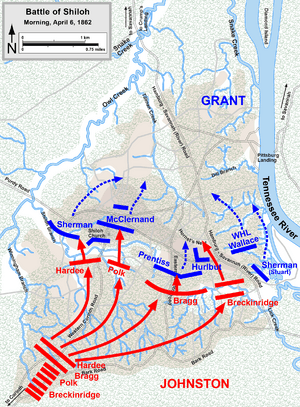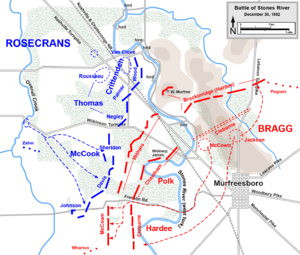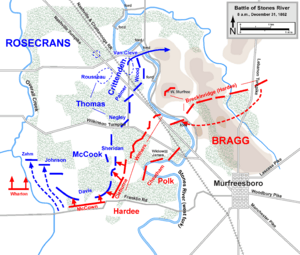John Q. Loomis facts for kids
Quick facts for kids
John Quincy Loomis
|
|
|---|---|
| Born | c. 1824 South Carolina |
| Died | December 4, 1869 (aged 44–45) Wetumpka, Alabama |
| Buried |
Wetumpka City Cemetery
|
| Allegiance | |
| Service/ |
|
| Years of service |
|
| Rank | Colonel |
| Commands held |
|
| Battles/wars | |
| Other work | Lawyer |
John Quincy Loomis (born around 1824 – died December 4, 1869) was an officer in the Confederate States Army during the American Civil War. He led a group of soldiers called a brigade.
Before the Civil War, Loomis fought in the Mexican–American War. After that, he became a lawyer in a small town. He believed that Southern states should leave the United States. He led a local group of soldiers during the early days of the Siege of Pensacola. When the American Civil War started, Loomis first commanded an artillery company. He then became a battalion commander in late 1861. Before the Battle of Shiloh, he was made a colonel and led the 25th Alabama Infantry Regiment. He was hurt while leading his regiment at Shiloh. Later, he commanded a brigade at the start of the Battle of Stones River. He was wounded again at Stones River and left the army. John Quincy Loomis went back to being a lawyer and died a few years after the war ended.
Contents
Early Life and Career
John Quincy Loomis was born around 1824 in South Carolina. He later became a lawyer in Alabama. In 1847, he joined the 1st Alabama Volunteer Infantry Battalion as a first sergeant. This was during the Mexican–American War. He served with his unit in Orizaba, Mexico, and left the army when the war ended in June 1848.
By 1850, Loomis was a lawyer living in Shelby. He married Mary Henry in Bibb County on December 19 of that year. Loomis and his wife moved to Wetumpka. This was a small town near Montgomery, the state capital. He became a well-known lawyer there. In 1856, he was chosen to represent Wetumpka at a big meeting in Savannah, Georgia. This meeting was a place where people talked about states leaving the Union. By 1860, Loomis and his wife had three sons and one daughter. He was also a leader in the local Masonic lodge. Loomis was the captain of the Wetumpka Light Guards, a local militia group. He led them in a parade in Montgomery in 1860.
The Civil War Begins
Loomis supported John C. Breckinridge in the 1860 presidential election. Breckinridge was a Southern Democrat who supported slavery. After Abraham Lincoln, a Republican, won the election, Alabama decided to hold a meeting about leaving the United States. Loomis wanted to be a delegate at this meeting, supporting secession. However, he lost the election in his county.
Even though he lost, Loomis's Wetumpka Light Guards joined the state army in November 1860. After Alabama left the Union in January 1861, his company and other Alabama and Florida militia groups were sent to take over U.S. military bases in Pensacola, Florida. They captured the Warrington Navy Yard. But they could not take Fort Pickens, where U.S. soldiers stayed strong. A truce was made, and the situation became a quiet siege for several weeks. In late February, Loomis's company returned to Montgomery.
After returning from Pensacola, Loomis left his role as captain of the Light Guards. On February 23, he became captain of Company E in the 1st Battalion, Alabama Artillery. While the Light Guards went to Virginia, Loomis recruited Company E in Wetumpka. His battalion became part of the Confederate army. They defended the port of Mobile, with Company E stationed at Fort Morgan and later Fort Gaines.
On September 17, Loomis left his captaincy. He became a lieutenant colonel of the new 1st Alabama Infantry Battalion. This battalion later joined with another to form the 25th Alabama Infantry Regiment. Loomis became the colonel of the 25th Alabama. This new regiment became part of Jones M. Withers' Army of Mobile.
Battle of Shiloh
In February 1862, the fall of Fort Donelson opened the Tennessee River for Union forces. They could now advance towards Corinth, Mississippi, an important railroad hub. To protect Corinth, many Confederate troops, including Loomis's regiment, were sent there. The Army of Mississippi gathered at Corinth under General Albert Sidney Johnston.
At the Battle of Shiloh, the 25th Alabama was part of Gladden's brigade. This brigade was in Withers' Division, which was part of Braxton Bragg's Corps. Loomis led only 305 men into battle because many soldiers were sick.
On April 6, at 7:00 a.m., the 25th Alabama attacked on the left side of their brigade. They pushed back the 16th Wisconsin Regiment. Loomis wrote that his men rushed forward, trying to do their best. They advanced into an open area called Spain Field. There, they fought fiercely and suffered many losses. General Gladden was badly wounded. Daniel W. Adams took command of the brigade, which had to retreat for a short time.
Another brigade, led by Martin Chalmers, arrived and helped flank the Union forces. Adams ordered an advance, supported by artillery fire. The Union troops, outnumbered, broke and ran. The 25th Alabama shared in the captured supplies from the Union camp. For several hours, the brigade stayed in reserve. Later that afternoon, they helped surround a Union division. Adams was wounded, and Colonel Zachariah C. Deas took command of the brigade. Around 4:00 p.m., Loomis was hit by a musket ball, which caused a concussion. He was unable to command. Major George D. Johnston took over the 25th Regiment for the rest of the battle.
Battle of Stones River
In August 1862, Loomis led the 25th Alabama during the Confederate invasion of Kentucky. However, his division was separated from the main army and missed the major Battle of Perryville. In December, General Deas was promoted but became ill. This left Loomis in command of the brigade before the Battle of Stones River. His brigade had about 2,400 men. It included several Alabama and Louisiana infantry regiments and an Alabama artillery battery.
The brigade was first on outpost duty near Las Casas. They were ordered back on December 29 and rejoined their division by December 30. They took a position on the right side of the line. In the afternoon, Union forces advanced. They pushed back Confederate pickets. An Alabama battery, supported by infantry, fired on them. Union troops forced the battery to retreat. But the 26th and 29th Alabama regiments, from Loomis's brigade, stood up from behind a fence and fired heavily on the Union soldiers. The 25th Alabama also moved up to the fence to stop another attack. The Union troops retreated. About 75 soldiers from Loomis's and another brigade were hurt that day.
The night before the main battle, Loomis's brigade was moved to a different division. The main attack on December 31 was delayed. When the battle began, Loomis led his brigade northwest into an open field. However, before he was out of the woods, a shell hit a tree branch, which fell and wounded him in the shoulder. This knocked him out of the fight. Colonel John G. Coltart took command and continued the attack. The brigade initially pushed back the Union troops but then suffered heavy losses as the Union forces fought back. Coltart remained in command for the rest of the battle.
By January 1863, Loomis was without a command. His regiment was combined with another. George D. Johnston took over the combined regiment. Loomis was sent to command the Hospital Guard in Atlanta. Before Stones River, he had been noted as unfit for field service due to rheumatism, a condition causing joint pain. Loomis resigned from the army on September 14, 1863, because of his health. He was known in the army as a skilled leader and trainer of soldiers.
After the War
After the war ended, Loomis went back to being a lawyer. In 1865, the state government chose him to be a judge in the state's chancery court system. He served as a judge until 1868. His youngest son died in 1867. John Quincy Loomis died in Wetumpka on December 4, 1869. He was buried in an unmarked grave at the city cemetery.




